A zoo where guests are allowed to feed the animals!
| Utsunomiya Zoo hardly crosses the
radar of most foreign tourists visiting Japan, but,
fortunately, it crossed mine. When I was planning a day trip
from Tokyo to Nikko, I stumbled upon a review of Utsunomiya
Zoo. I read that, unlike at most zoos in the U.S., at
Utsunomiya Zoo, guests are allowed, and even encouraged, to
feed many of the animals! We were already planning to change
trains in Utsunomiya on our way to Nikko, so my friend and I
decided to pay Utsunomiya Zoo a visit. At the Utsunomiya train station, we stopped at a tourist information booth for advice on how to get to the zoo using the bus system. At the same time as we were getting directions, two Japanese teen girls were asking another booth attendant about traveling to the zoo. “You go together,” one of men told us, gesturing to the girls. And so we did. At the bus stop just outside the train station, we waited for the correct numbered bus. It arrived just a few minutes later. We climbed aboard, took a ticket from the dispenser next to the driver, and told the driver where we wanted to get off, so that he would be sure to stop. After about 30 minutes, we paid our fare of 500 yen each and were dropped off by the side of a small road across the street from a weathered convenience store. Unsure of which way to go, the girls asked an older woman, who was tending her immaculate garden, for directions. Then we walked straight up the road (the same direction we’d been traveling by bus) for about ten minutes. When we saw a giraffe-shaped sign ... |
||
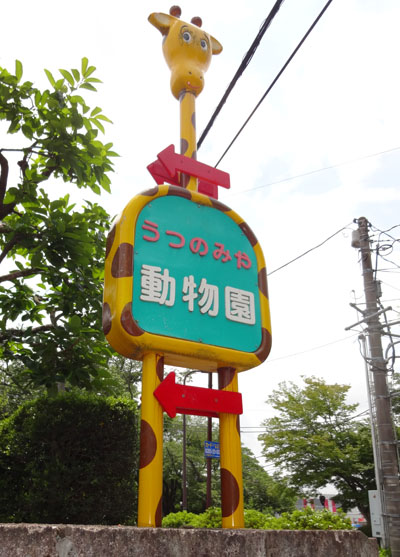 |
||
| ... we turned right and walked past a large rice paddy field ... | ||
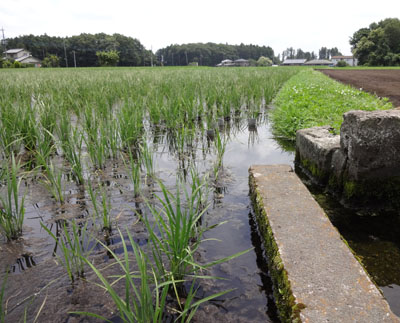 |
||
| ... through a parking lot watched over by a tall robot ... | ||
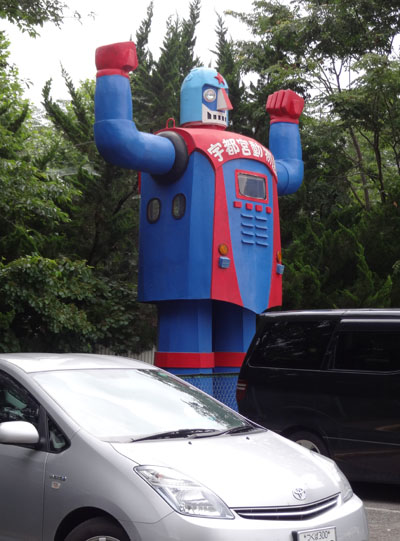 |
||
| ... and to the front entrance of Utsunomiya Zoo. | ||
 |
||
| The woman at the entry gate collected our admission fee (about 1,000 yen each), and we purchased two little brown paper bags (100 yen each) that contained food, not for us, but for the animals. Just inside the zoo entrance was a small shopping area that looked like it had seen better days. Nearby was an amusement park for the preschool set. Most everything was worn and faded. | ||
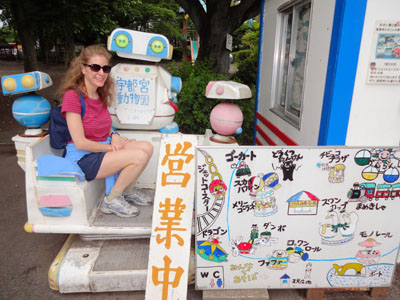 |
||
| Ride vehicles that had
long ago lived out their useful life lay off to the side,
possibly to serve as decorations. It was as if we had found
one of Japan’s abandoned theme parks, like a small town
version of the one in Hayao Miyazaki‘s Studio Ghibli film,
Spirited Away. The first animals that we saw were chimpanzees. The animals seemed content enough, until I moved in for a look. Suddenly, the chimps became downright hostile, shrieking and jumping about. One chimp actually spit at me! We moved on to the sedate children’s area. There, a few toddlers with their parents admired hoofed animals in enclosures. The rest of the children cuddled guinea pigs under the guidance of a zoo employee. We made our way back to the main zoo. The zoo was run down and forlorn-looking, and many of the enclosures were smaller than those at the zoos that I’ve visited back home, but the animals seemed clean and well nourished. We admired the adorable lemurs and monkeys, a few giraffes, a sleeping hippopotamus, an Asian elephant, raccoon dogs (which I was excited to see thanks to the Studio Ghibli film, Pom Poko), a tiger, and lions. At the penguin enclosure, we caught part of the SeaWorld-style “keeper talk,” in Japanese of course, where enthusiastic penguins followed the keeper about as she fed them high-quality-looking fish. |
||
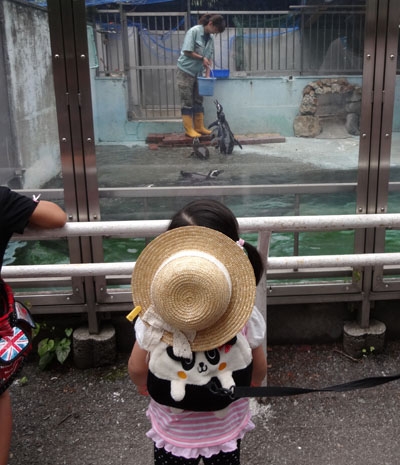 |
||
| After having walked through the entire zoo, it wasn’t clear to me which animals could be fed by zoo guests. I had seen other guests feeding the giraffes from an elevated platform by the giraffe enclosure, and so I followed suit. The giraffes gently slipped food from my hand with their black tongues. | ||
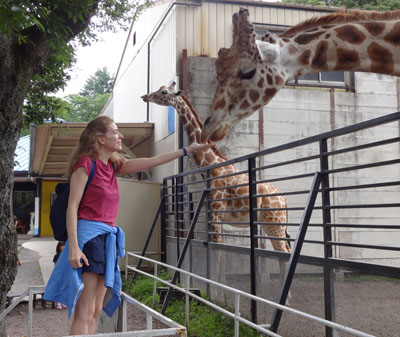 |
||
| Because I’ve worked with an elephant in the past, I also fed the Asian elephant, although she was far enough away from the barriers that I’m not sure that guests were supposed to feed her. She stretched out her long trunk to take the apple slices that I offered. | ||
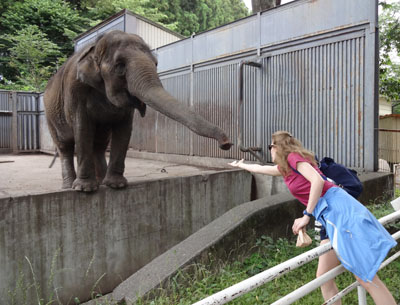 |
||
| Then I noticed other guests feeding the monkeys and lemurs. I eagerly joined them, breaking the fruits, vegetables, and crackers from my bag into smaller pieces for the animals’ tiny hands. When the soft little pads of the animal’s hands touched my fingers, I couldn’t help but smile. | ||
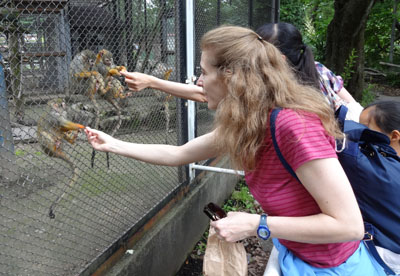
 |
||
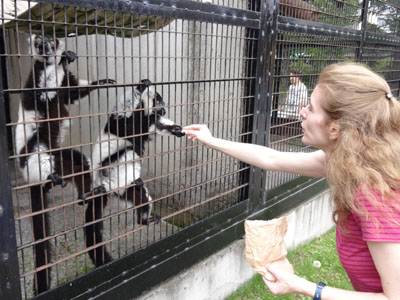 |
||
| After about 1 ½ hours at the zoo, we walked back to the
weathered convenience store and took a bus back to the
Utsunomiya train station. We spent that afternoon in Nikko, where we visited the popular Toshogu Shrine. Although Nikko, nestled in wonderfully atmospheric green mountains with a layer of foggy mist, and the colorful, elaborate Toshogu Shrine were incredible, our visit to Utsunomiya Zoo, although it certainly isn’t a tourist attraction, proved to be an interesting addition to our day. |
||
I did this in 2013 in Utsunomiya, Japan. ~Jen (California, USA) P.S. Read the novel inspired by my trip to Japan. Get your copy of Lost in Tokyo at Amazon.com! |
||
|
ABOUT THE AUTHOR Jen is also known as J.W. Lynne, a bestselling author of twelve novels. Click on any of the titles below to see the book on Amazon! THE UNKNOWN: Eight kids learn the shocking reason why they were kidnapped. ABOVE THE SKY: A girl and boy fall in love in a dangerous world filled with secrets. THE DARKNESS OUTSIDE: Ten families are locked in a bunker to take a simulated trip to the moon. KID DOCS: An experimental program transforms kids into doctors. WILD ANIMAL SCHOOL: A girl falls in love at an exotic animal ranch. WHAT HE DIDN'T TELL ME: A traumatized girl meets a boy with a horrible secret. IF I TELL: A teen wonders if her father is a serial killer. Besides reading books and dreaming up stories to write, Jen's favorite activities are singing along to musical theater soundtracks and hiking in California's beautiful parks. **Jen's books are available on Kindle Unlimited.** |
||
 |
||
|
